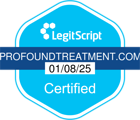Xanax Addiction (Alprazolam): Signs and Treatment
Xanax is a medication used to treat anxiety and depression. But if you use it irresponsibly, a Xanax addiction may form.
What is Xanax?
Xanax is a drug prescribed to treat depression and anxiety. It belongs to a class of medications known as benzodiazepines and it acts on the central nervous system by producing GABA in the body to create a calming effect.1
Xanax can be addictive when taken irresponsibly. This can mean taking it outside of your prescribed dosage, mixing it with other substances, or using someone else’s prescription.

Contact Profound Treatment to Learn More
Our team is standing by to discuss treatment options with you. Your call is completely confidential and no obligation is required.
Understanding Xanax Addiction
Xanax works by helping increase serotonin in the brain, which is why it’s used as a medication to help with anxiety and depression. After taking the drug for a while, your body will get used to having it in its system. When the drug isn’t present and these feelings of euphoria from Xanax have gone away, your body will begin to exhibit unpleasant symptoms.
The only way to keep these symptoms at bay is to keep using the drug, which can perpetuate a Xanax substance abuse disorder. This is why it’s important to undergo detox at a medical facility.
Xanax Substance Use Disorder (SUD)
You or a loved one may develop a dependence or addiction to Xanax if you aren’t aware of how easily it can progress. There is generally a cycle of how addiction starts.
Xanax SUD Progression Cycle
The timeline for this cycle can look different for everyone, but generally, it progresses in the following order:
- Initiation: Initiation involves becoming introduced to the drug.
- Experimentation: Experimentation occurs when the drug is taken recreationally. It doesn’t always lead to Xanax addiction, but it can later on.
- Regular Abuse: Regular abuse is a turning point for many people. It is the stage when drug use becomes more common, and the body starts to crave the substance.
- Dependence: Dependence occurs when a person is unable to stop using the drug despite being aware of its negative effects.
- Substance Use Disorder: A substance use disorder will be accompanied by withdrawal symptoms that can only be avoided when the drug is in the person’s system. It is typically accompanied by changes in mood and behavior as well as physical conditions.
Xanax Addiction Signs
Common Xanax addiction signs can be physical, psychological, and behavioral.
Physical Symptoms
- Drowsiness: Xanax drugs calm the nervous system. If you take them excessively, they will cause drowsiness.
- Increased Salivation: A study of Xanax effects showed it to increase salivation in 4% of users.
- Poor Motor Coordination: Misuse of Xanax can adversely affect the central nervous system interfering with motor skills.
- Constipation: Constipation is a common Xanax side effect.
- Dry Mouth: Xanax is an anticholinergic medication, which means it blocks and inhibits the neurotransmitter acetylcholine resulting in dry mouth.
Psychological Symptoms
- Confusion: Confusion is one of the common Xanax addiction symptoms.
- Agitation: It may seem odd that a drug that’s supposed to calm you down causes annoyance. But if you take excessive doses, it will affect the brain’s ability to function properly leading to anger outbursts.
- Changes in Behavior: The changes Xanax causes in the brain can lead to other changes in behavior including depression anxiety, psychosis, and more.
- Trouble Remembering Things: A 2016 study showed Xanax to cause a significant impairment in visual memory.
Behavioral Symptoms:
Behavioral signs of Xanax addiction may include:
- Slurred Speech: Xanax calms the nervous system and may cause slurred speech if excessive amounts are taken.
- Doctor Shopping: An individual may go to different doctors to get multiple prescriptions, so they have access to extra Xanax.
- Engaging in Risky Behavior: Xanax affects the brain and may interfere with judgment, so you are more likely to engage in risky behavior.
- Inability to Reduce Intake: Once withdrawal symptoms set in, you will find it difficult to reduce your Xanax intake.
Understanding Xanax Withdrawal
Xanax withdrawal occurs when the body gets used to having Xanax in its system. When Xanax is not present, the body will start to exhibit withdrawal symptoms.
Here are some of the Xanax withdrawal symptoms you may experience:4
- Anxiety
- Hyperventilation
- Loss of appetite
- General discomfort
- Abnormal sensations
- Hypersensitivity to light and sound
- Psychosis including hallucinations
- Muscle spasms
- Sleep problems
- Seizures or tremors

Duration of Withdrawal
The length of withdrawal varies depending on how long you were addicted to the drug and how much of the drug you were taking. But in most cases, symptoms will subside within ten to fourteen days. In rare cases, they may last longer. A Xanax withdrawal timeline generally looks something like this:
- First 24 Hours After Last Dose: This is when the withdrawal symptoms will first set in.
- 24-72 Hours After Last Dose: Symptoms will be most intense during this period.
- 4-14 Days After Last Dose: During this time, you will continue to feel symptoms, but they will begin subsiding and will gradually go away completely.
Xanax Addiction Treatment
Xanax dependence generally requires a five-step treatment process as follows:
- Detox: During this stage, your body will rid itself of illicit substances. You will experience withdrawal symptoms, but a rehab staff member will see you through the process and keep you as comfortable as possible.
- Inpatient Treatment: After detox is complete, you may check into an inpatient treatment program. You will stay in the facility for anywhere from one to three months. You will be monitored and provided with therapy.
- Outpatient Treatment: Outpatient treatment can be a primary treatment or a follow up to inpatient treatment. It involves splitting your time between therapy and everyday life.
- Behavioral Therapies: Behavioral therapies will be provided during the inpatient and outpatient process. They aim to change negative thought processes to yield healthy behaviors.
- Ongoing Treatment and Relapse Prevention Strategies: Your therapists will provide ongoing treatment and relapse prevention strategies so you can maintain sobriety long-term.
Get Treatment Today for Xanax Addiction
There are many facilities that offer treatment for addiction to Xanax, but Profound Treatment takes an approach that sets us apart.
Profound Treatment is a luxury rehab facility in California. We use an evidence-based treatment model that addresses the needs of the mind, body, and soul. We work out customized treatment for each patient ensuring they get the care that’s best suited to their needs.
Reach Out and Begin Healing
Don’t let a Xanax addiction keep you from enjoying the things you love. Reach out to Profound Treatment to get the deep level of care you require.
Useful Links
Licensed by the State Department of Health Care Services.
Profound Healing Centers License No: 191092BP Exp. 5/31/26 (current/active)
Profound Healing Centers License No: 191092AP Exp. 7/31/25 (current/active)
Profound Treatment License No: 191047CP Exp. 1/31/27 (current/active)
Profound Treatment License No: 191047AP Exp. 8/31/26 (current/active)
Profound Treatment License No: 191047EP Exp: 3/31/26 (current/active)
Profound Treatment License No: 191047DP Exp. 9/30/25 (current/active)
Click here for more information about DHCS licensing.








